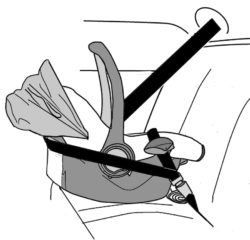FMVSS 213 requires CRs to be tested while installed using a lap-only belt. Therefore, there is no required U.S. test to measure the effectiveness of installations using Euro-routing, since that technique involves a lap-shoulder belt. However, from experience in Europe and through voluntary testing, many manufacturers recognize the benefits of Euro-routing and choose to offer it as an option on CRs sold in North America.
If a lap-shoulder belt seems to be too short for Euro-routing, try this technique:
- Route the lap portion of the belt through the CR belt path guides (across the child’s leg area), but don’t buckle the belt.
- Wrap the shoulder portion of the belt around the back of the CR (following model-specific instructions, if any, for using a guide on the back of the CR shell).
- Buckle the belt, and then complete installation, as instructed, by setting the CR to the proper angle and tightening the belt.
By buckling the belt after the shoulder belt has been routed (not before), a belt that may seem to be too short for Euro-routing is often ample. This technique is also less likely to tempt the user to tilt the top of CR shell forward to enable shoulder belt placement (which can be awkward or even risky if a baby is seated in the CR).

